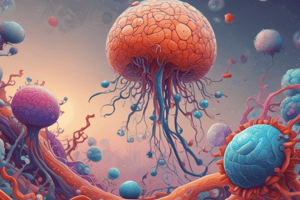Podcast
Questions and Answers
Who was the first person to observe and describe cells?
Who was the first person to observe and describe cells?
- Robert Hooke (correct)
- Anton van Leeuwenhoek
- Matthias Schwann
- Robert Schleiden
What did Robert Hooke compare the structures he observed in cork to?
What did Robert Hooke compare the structures he observed in cork to?
- Strands of hair
- Feathers
- Seashells
- Honeycombs (correct)
Who provided the first clearly stated definition of cell theory?
Who provided the first clearly stated definition of cell theory?
- Anton van Leeuwenhoek
- Robert Hooke
- Matthias Schwann (correct)
- Louis Pasteur
Which organelle is responsible for protein synthesis in a cell?
Which organelle is responsible for protein synthesis in a cell?
What is the function of the plasma membrane in a cell?
What is the function of the plasma membrane in a cell?
What does the cytoplasm of a cell contain?
What does the cytoplasm of a cell contain?
What is the function of the nucleus in a cell?
What is the function of the nucleus in a cell?
How are cells classified based on the presence of a nucleus?
How are cells classified based on the presence of a nucleus?
What type of cells have the potential to differentiate into various cell types?
What type of cells have the potential to differentiate into various cell types?
Why are electron microscopes important in the study of cells?
Why are electron microscopes important in the study of cells?
Which type of organisms consist of multiple cells working together to form tissues?
Which type of organisms consist of multiple cells working together to form tissues?
What do cells carry out that is necessary for life?
What do cells carry out that is necessary for life?
Flashcards are hidden until you start studying
Study Notes
Cells: The Fundamental Unit of Life
Cells are the basic units of life that carry out the processes necessary for living organisms to function. They were first observed and described by Robert Hooke in 1665, who noted that when he looked at a thin slice of cork under a microscope, he saw structures that resembled honeycombs or repeated circular and square units. This observation marked the beginning of the study of cells and their role in living organisms.
Discovery of Cells
The term "cell" was first used by Robert Hooke in 1665 when he observed plant cells under a microscope. He described them as having a regular, orderly structure that reminded him of the cells in a monastery. In the 1830s, two scientists, Schleiden and Schwann, provided the first clearly stated definition of the cell, stating that all living creatures, both simple and complex, are made out of one or more cells. This definition became known as cell theory.
Cellular Structure and Function
Cells are composed of various structures and organelles that perform specific functions. The plasma membrane, also known as the cell membrane, is a thin coat of phospholipids that surrounds the cell and serves as its boundary with the environment. The cytoplasm is the part of the cell inside the plasma membrane and contains many cell structures, such as ribosomes, where proteins are made, and DNA, which contains the genetic instructions for protein production. The nucleus is a membrane-bound organelle that contains the genetic material of the cell.
Cellular Processes
Cells carry out various processes necessary for life, such as taking in nutrients, converting these nutrients into energy, and removing waste products. They also reproduce by dividing, producing new cells that arise from other living cells. Cells can be classified into prokaryotic and eukaryotic, depending on the presence or absence of a nucleus and other membrane-bound organelles.
Cellular Diversity
Cells are diverse and can be found in various organisms, from bacteria to humans. Some organisms, like bacteria, are unicellular, consisting of a single cell, while others, like humans, are multicellular, with many cells working together to form tissues, organs, and organ systems.
Cellular Complexity
As technology has advanced, particularly the development of the electron microscope, scientists have been able to study cells at a more detailed level, revealing the intricacy of their structure and function. This has led to the discovery of subcellular compartments and the study of cellular communication and signaling.
Stem Cells
Stem cells are a type of cell that has the ability to differentiate into various cell types, such as bone, muscle, and nerve cells. They have the potential to become a source for tissue engineering and regenerative medicine, particularly in the field of dentistry, where they can be used for periodontal tissue repair and dentin regeneration.
In conclusion, cells are the fundamental unit of life, responsible for carrying out the processes necessary for living organisms to function. Their discovery and study have led to a better understanding of life itself and paved the way for advancements in medicine and biology.
Studying That Suits You
Use AI to generate personalized quizzes and flashcards to suit your learning preferences.




